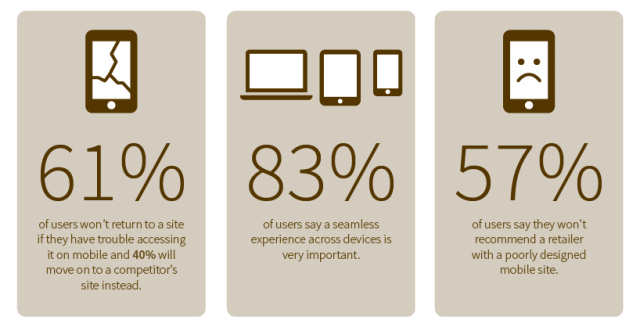How to Attract Teens as Customers & Employees with M Commerce
“M Commerce” is a new buzzword for transactions conducted on phones, but mobile commerce has been on the rise for the past few years. Additionally, it’s been reported that Gen Z, the first digitally native generation, not only prefers digital solutions but expects them. Attracting the next generation as customers and employees will mean diving head first into mobile.
As you can see from the stats above from Mckinsey, Salesforce, and Formstack, a clean mobile experience is essential. Now is the time to elevate your mobile strategy and understand how you can utilize it to provide value to customers and employees. Below, we’ll walk you through how to get started with mobile commerce to attract Gen Z and millennials to your business as customers and employees.
Provide unique in-store experiences with mobile
Driving customers in-store will give you the chance to provide them with a great experience and mobile is increasingly becoming a part of that. 72% of millennials said that they would provide an email or use a social account to log in to a store’s wifi if they provided an instant access to a gift or discount, and 69% said they would do it to enroll in a loyalty program. Gen Z, the generation after millennials, prefers to shop in-store and is more loyal to a brand when they provide them a memorable experience. Make sure your mobile experiences are adding value to your customers. Whether that’s a deal, providing a fast checkout, or giving them a way to tell a staff member they need help, the value of the experience is important. A quality in-store interaction makes people not only more likely to shop with you again, but also more likely to recommend you to others.
Mobile marketing
Young Millennials and Generation Z are the first generations of digital natives, and they are more open to advertising on their phones than previous generations. However, they do not want to be inconvenienced— 32% are more likely to click on an ad that doesn’t take them out of the app they are in. That means your marketing efforts need to be placed where your target customers are— think about social media campaigns as well as email. Social advertising does not just consist of paid ads and organic page posts, so get creative when thinking about social advertising. Consider working with influencers to reach a new audience that may not know you yet, do collaborations with other business, or do a live event and promote and showcase it across social.
Just as important as reaching this generation where they are, is your website functionality on mobile. Shopify reported that 71% of retailers don’t offer a mobile-friendly experience, yet 53.5M shoppers accessed mobile shopping on their smartphones in 2015 (and that number is expected to hit 97.5M in 2018). Most users are going to find you on their phones, and if your website is not optimized for a seamless mobile experience, they will probably rule you out and not recommend you to others.
M Commerce
One out of every ten e-commerce dollars was spent on a mobile device in 2015 and mobile payment options are only continuing to grow. Provide your customers with the most seamless experience you can by allowing them payment flexibility. Offering NFC payment options (Near Field Communication which allows two devices within a certain distance to communicate) will become increasingly important to the next generation. While they may prefer to shop in-store, they adopt and expect technological solutions. 77% of adults used NFC to pay in 2015, and as the next generation of consumers starts to manage their own money, it is predicted that that number will keep increasing. Start attracting these consumers now by offering and advertising with easy ways to pay from their phones.
Invest in employee scheduling software, you can boost productivity at your organization and use the time you save to grow other areas of your business.
Mobile solutions aren’t just attracting customers
Technology isn’t just attracting Gen Z as consumers, it’s also a criterion for their jobs. They were born into technology and expect it in their workplace. Nielsen reports that 98% of millennials have a smartphone and a study conducted by Deloitte found that they check them, on average, 74 times per day. Work with your employees mobile usage and give them the ability to see their schedule, clock-in, and swap shifts all on their phones with desktop and mobile scheduling software. Ultimately, you will spend less time creating a manual schedule and it’s an important draw for the next generation of employees.
You can take the mobile-embrace a step further by adopting these devices on the floor. Employees can use them to create better customer experiences by empowering your employees with in-hand knowledge. They can check stock, look up a customer in a loyalty program, or check people out when lines get long.
Technology has now weaved its way into many aspects of our lives, and you can use the new solutions to create better experiences for your customers and employees. The cost to starting these programs is minimal but will ultimately increase your bottom line. Have you already employed mobile solutions? What’s the one you can’t live without?







